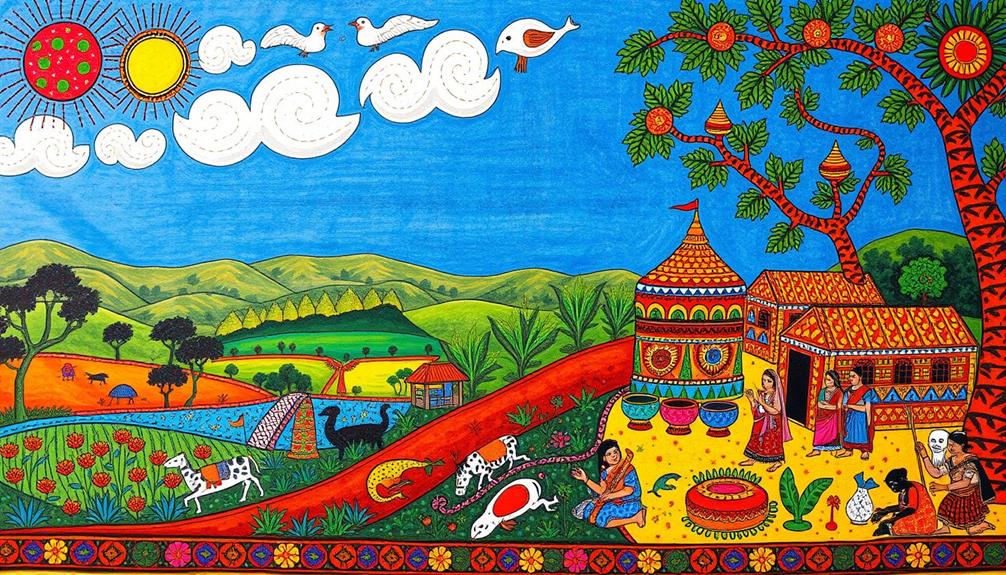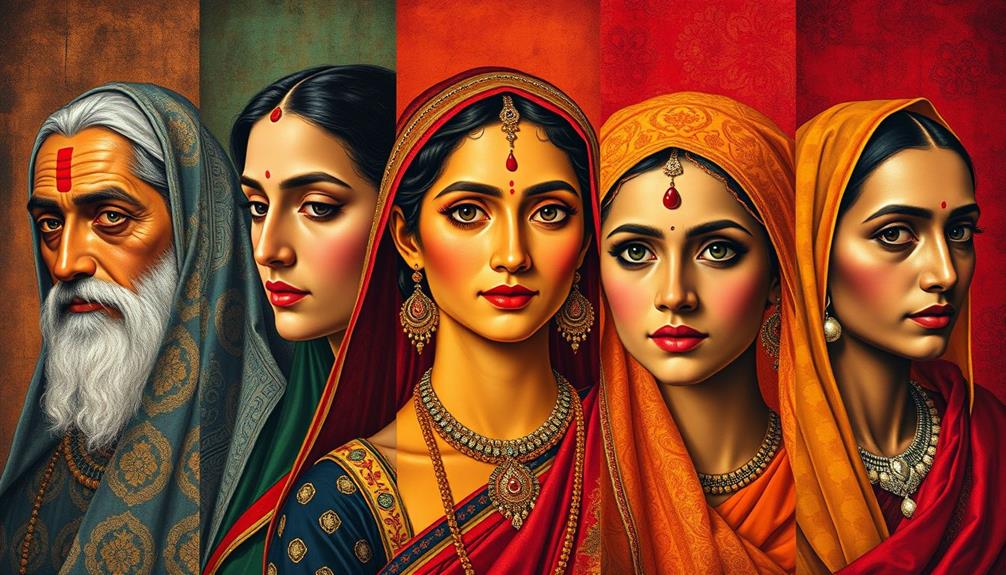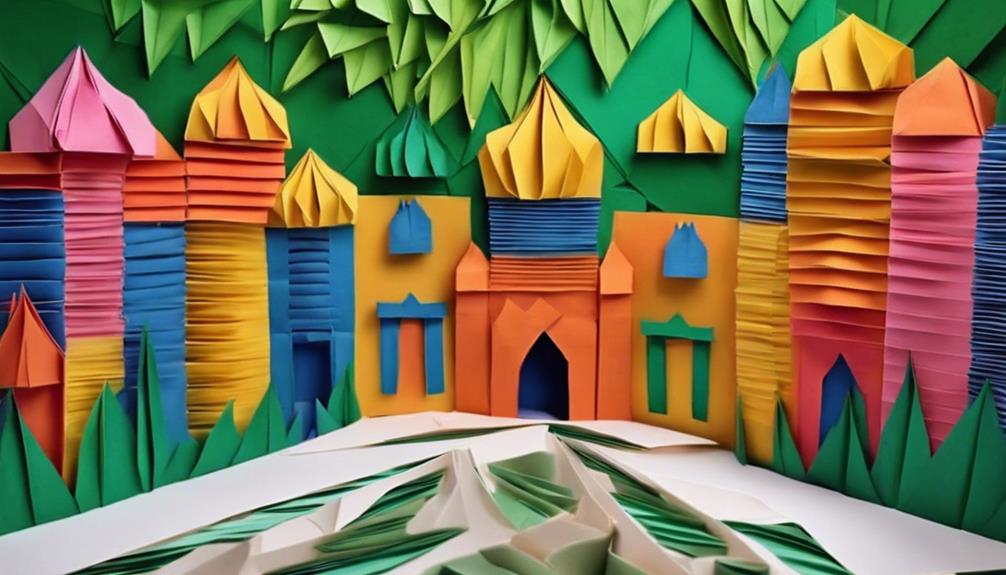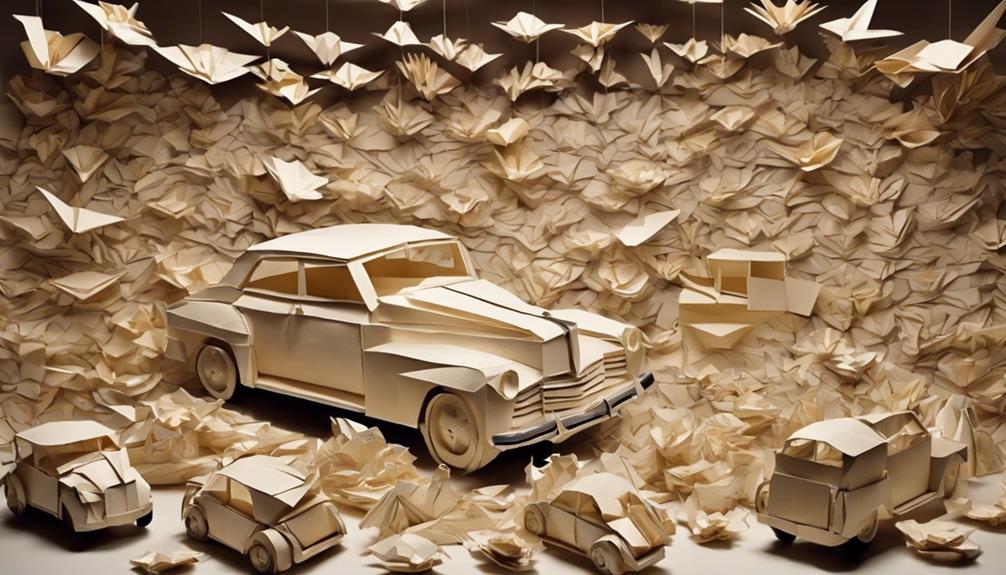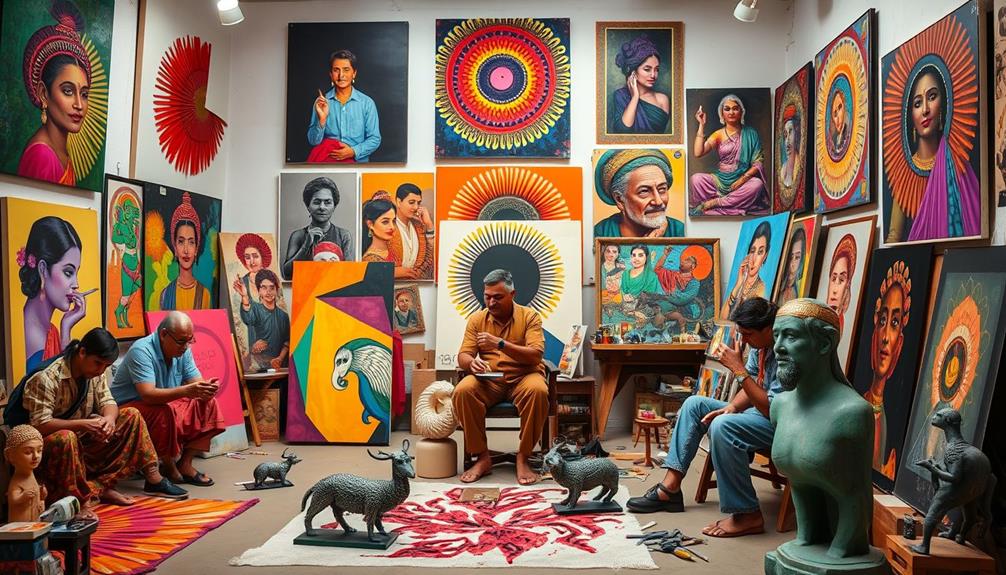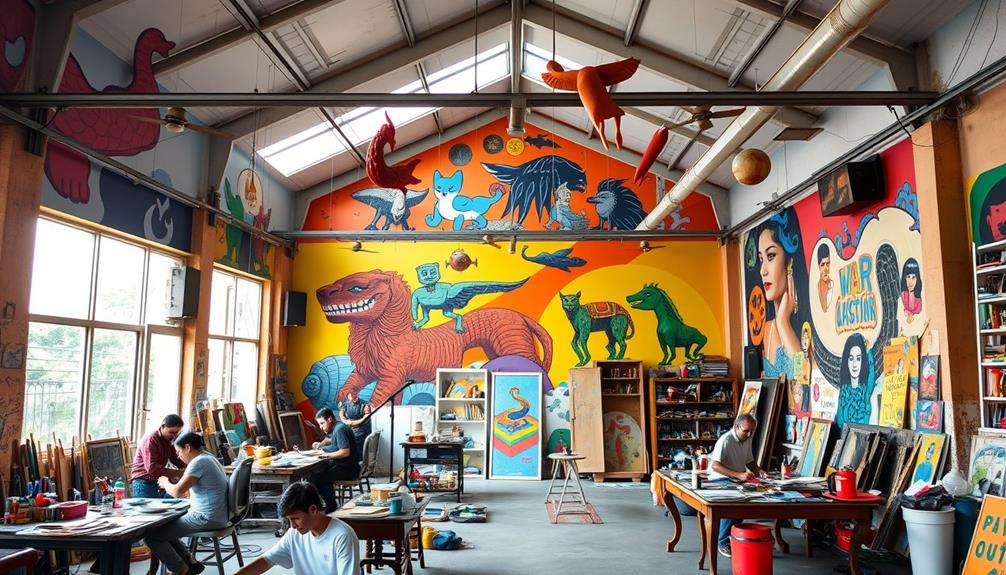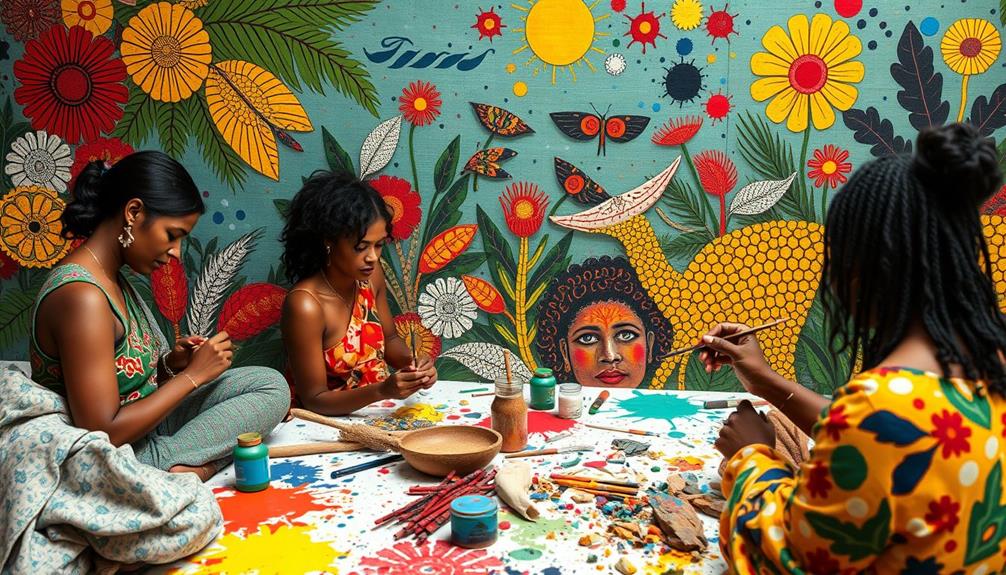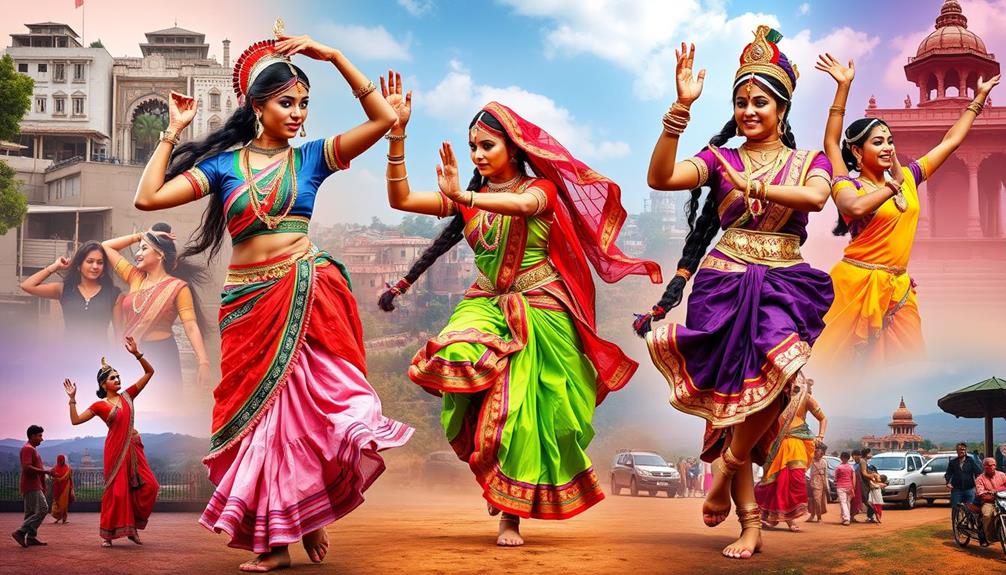Madhubani painting, originating from Bihar's Mithila region, has transcended its roots, making a significant impact on Bengal's cultural landscape. This vibrant art form, initially created by women on mud walls, showcases intricate line work and vivid colors. You'll find distinct styles like Bharni and Kachni, each telling stories of Hindu deities and local folklore. Traditionally a means for women to express themselves, it now provides financial independence. With its growing global recognition, Madhubani art has also fused with contemporary fashion, opening new avenues for artists. There's so much more to uncover about this beautiful tradition and its journey!
Key Takeaways
- Madhubani painting originated in the Mithila region of Bihar, commissioned for Sita's wedding during the Ramayana era.
- The art form features intricate line drawings and vibrant colors, with styles like Bharni, Kachni, and Godna.
- Women artists play a crucial role, gaining financial independence through cooperative societies while preserving cultural narratives.
- Madhubani art has gained global recognition since 1934, with international exhibitions showcasing its significance and appeal.
- Contemporary adaptations include fashion collaborations and digital art, ensuring the tradition remains relevant in modern contexts.
Historical Roots of Madhubani Painting
Madhubani painting, deeply rooted in the Mithila region of Bihar, India, has a rich history that dates back to the Ramayana era. You'll find that this traditional Indian art form emerged when King Janaka commissioned stunning artworks for the wedding of his daughter, Sita.
Initially, women created these vibrant paintings on mud walls and floors, using natural dyes to depict local myths, nature, and daily life. This craft has been lovingly passed down through generations, preserving the cultural heritage of the region. Remarkably, just as cats exhibit signs of attachment and emotional responses to their environment, the emotional depth captured in Madhubani paintings reflects the sentiments of the artists and their communities, showcasing their connection to their traditions and surroundings.
In the 20th century, Madhubani painting gained recognition as a professional craft, particularly after British officer William G. Archer discovered it in 1934. His efforts played an essential role in bringing this beautiful art form to international acclaim.
The Indian government later recognized its significance by granting it a Geographical Indication (GI) tag, ensuring the protection of its origins and traditional practices. Today, you can see Madhubani art evolving from ephemeral wall decorations to more permanent surfaces like canvas and cloth, allowing it to reach a wider audience while maintaining its historical roots.
Distinctive Features and Styles
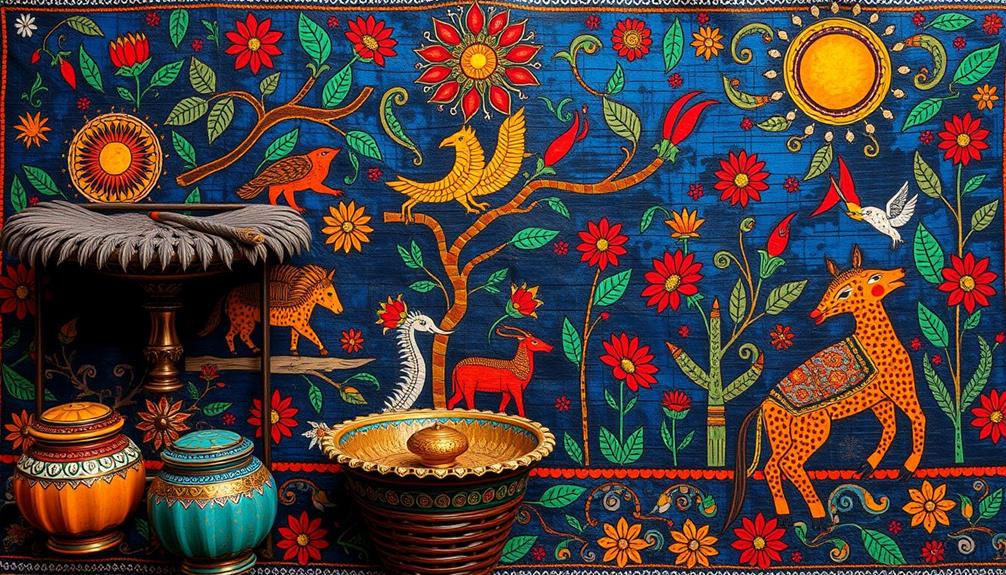
One of the most striking aspects of Madhubani painting is its intricate line drawings, which capture the viewer's attention with their vibrant colors and detailed designs.
This traditional art form showcases a variety of distinctive features that reflect the cultural richness of the Mithila region, similar to how essential oils can promote wellness through their therapeutic properties.
Here are three key characteristics you'll appreciate in Madhubani paintings:
1. Diverse Styles: You'll find several styles within Madhubani, including Bharni, known for its vibrant color filling; Kachni, which emphasizes fine line work; and Godna, incorporating tattoo motifs. Each style tells its own story.
2. Natural Materials: The artists utilize eco-friendly tools like twigs, brushes, and matchsticks, and the colors come from organic sources such as turmeric and lampblack.
This connection to nature enhances the artwork's authenticity.
3. Symbolic Motifs: Expect to see traditional motifs depicting Hindu deities, nature, and social events.
These elements not only beautify the paintings but also convey cultural narratives and spiritual beliefs.
Cultural Significance and Women's Role
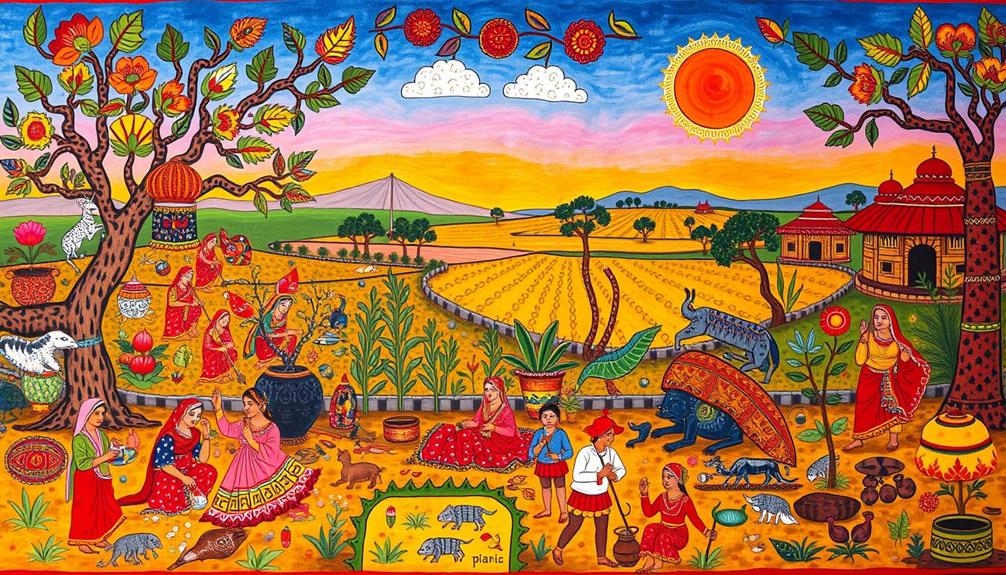
While exploring the cultural significance of Madhubani painting, you'll discover how this art form has become an important means of expression for women in the Mithila region. Traditionally created by women painters, these vibrant artworks often depict themes from Hindu mythology and local folklore, making them a significant medium for cultural storytelling.
The empowerment of women through artistic expression can also be likened to how trust issues in relationships can affect personal dynamics, highlighting the significance of mutual respect and understanding.
Madhubani painting doesn't just serve an artistic purpose; it empowers rural women economically. By participating in cooperative societies and local markets, they generate income and gain financial independence. This economic upliftment is essential in a landscape where traditional roles often limit women's opportunities.
Moreover, women artists play a key role in preserving and innovating the Madhubani tradition. They pass down techniques and motifs through generations, often teaching their daughters the skills necessary to continue this rich cultural heritage.
The recognition of Madhubani painting, particularly through artists like Sita Devi and Ganga Devi, has elevated women's status both locally and internationally.
As you explore deeper, you'll see that women's contributions to Madhubani painting not only reflect personal identity but also reinforce the socio-cultural narratives of the Mithila region, enriching its community pride and cultural continuity.
Common Themes and Motifs
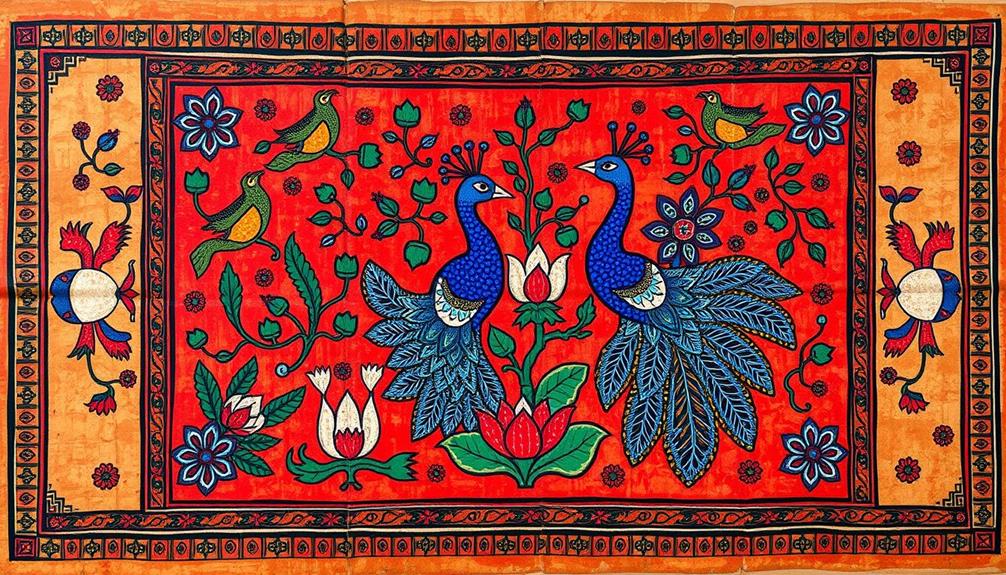
Commonly, Madhubani paintings showcase a rich tapestry of themes and motifs deeply rooted in Hindu mythology and local traditions. These artworks often serve as a means of storytelling, capturing not just visual beauty but also the essence of the community's identity.
You'll find that these vibrant artworks not only celebrate divine figures but also reflect the essence of life in the Mithila region. Here are three common themes and motifs you'll encounter in Madhubani art:
- Hindu Mythology: Deities like Rama and Krishna are frequently depicted, illustrating essential narratives and legends that connect viewers to their cultural heritage.
- Nature: The beauty of flora and fauna is captured in intricate patterns, along with celestial bodies like the sun and moon, emphasizing the connection between the community and its environment.
- Social Traditions: Scenes of weddings, births, and festivals are portrayed, highlighting the rituals and ceremonies that form the foundation of community life.
These themes and motifs not only showcase the skill of the artists but also serve to preserve the cultural values and beliefs of the region.
Techniques and Materials Used
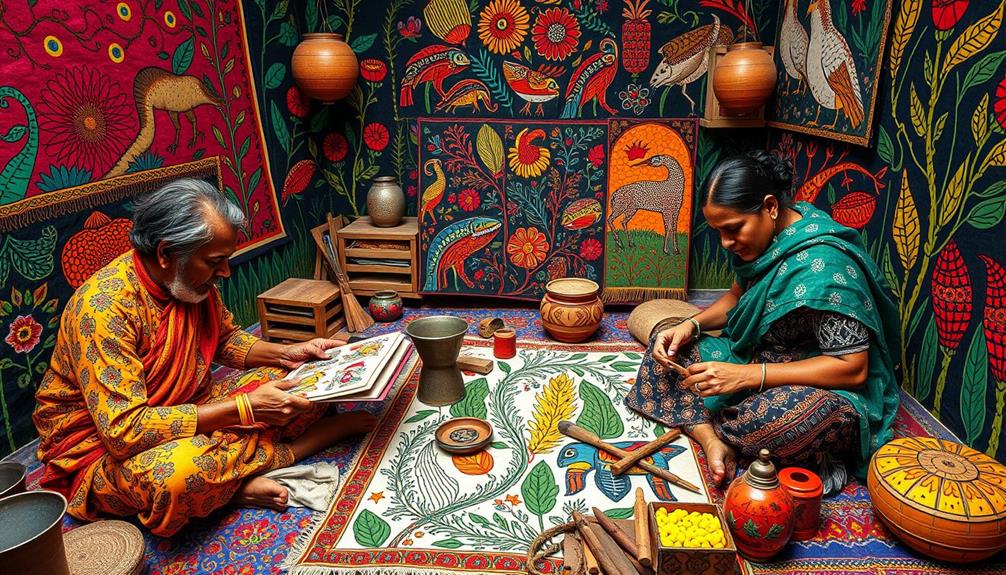
When you explore Madhubani painting, you'll notice the traditional techniques and natural materials that artists use to create their vibrant works.
They rely on organic pigments from sources like turmeric and charcoal, showcasing a deep connection to their environment. The use of natural resources mirrors the principles found in herbal preparation methods, emphasizing the importance of utilizing what nature provides.
As you observe the evolving styles, such as Bharni and Kachni, you'll appreciate how these variations highlight the rich cultural heritage of the Mithila region.
Traditional Painting Techniques
In Madhubani painting, artists skillfully utilize natural dyes and pigments sourced from turmeric, cow dung, and plant extracts, ensuring vibrant colors and eco-friendliness.
This traditional art form has evolved over time, allowing artists to showcase their creativity on various surfaces like canvas, cloth, and handmade paper. The use of natural materials not only enhances the aesthetic appeal but also reflects a growing trend towards sustainability in art, similar to the movement seen in health-aware candy options.
The techniques used in this unique art form are diverse, with each style featuring its own distinctive methods.
Here are three key elements of traditional Madhubani painting techniques:
- Intricate Tools: Artists often use twigs, brushes, and matchsticks to create detailed line drawings and patterns, which adds depth and precision to their work.
- Geometric Patterns: Many paintings emphasize geometric designs alongside natural elements, which enhances the visual storytelling aspect of the artwork.
- Unique Styles: Madhubani encompasses several styles, including Bharni, Kachni, and Godhana, each with its thematic representations and applications of techniques.
Through these traditional techniques, Madhubani artists continue to convey rich narratives, drawing inspiration from Hindu mythology and village life, ensuring that this vibrant art form remains alive and relevant.
Natural Materials Utilization
Madhubani painting thrives on its use of natural materials that not only enhance the artwork's vibrancy but also promote sustainability. In the Madhubani district, traditional artists utilize various eco-friendly colors derived from natural dyes sourced from plants and minerals. By doing so, they guarantee that their art remains environmentally friendly while showcasing brilliant hues.
The table below highlights some common materials and their sources used in Madhubani painting:
| Material | Source | Purpose |
|---|---|---|
| Cow dung | Livestock waste | Base texture and adhesion |
| Charcoal | Burnt wood | Black pigment (lampblack) |
| Turmeric | Turmeric root | Yellow pigment (ochre) |
| Plant extracts | Various plants | Diverse colors and textures |
Artists employ tools like fingers, twigs, brushes, and matchsticks to create intricate patterns. Initially painted on mud walls, these artworks have shifted to cloth and handmade paper, adapting to modern needs. This dedication to using natural materials not only preserves the traditional techniques but also celebrates the rich cultural heritage of Madhubani painting.
Evolving Artistic Styles
Evolving artistic styles in Madhubani painting showcase a vibrant fusion of traditional techniques and modern influences.
These folk art masterpieces, originally adorned on mud walls, have changed onto various surfaces like cloth, handmade paper, and canvas. This shift not only enhances accessibility but also aids in preservation, reflecting the importance of essential kitchen gadgets in modern cooking.
As artists experiment with new techniques, they bring fresh perspectives to this ancient art form.
Here are three key elements that define the evolving artistic styles in Madhubani paintings:
- Diverse Tools: Artists use fingers, twigs, brushes, nib-pens, and even matchsticks to create intricate line drawings and vivid fills, each tool contributing to the unique character of their work.
- Innovative Materials: While traditional natural dyes and materials like cow dung and plant extracts remain prevalent, many artists now explore modern paints and mediums, allowing for more vibrant expressions.
- Distinct Styles: Madhubani encompasses various styles such as Bharni, Kachni, and Godhana, each highlighting unique themes and techniques, reflecting a rich tapestry of artistic expression that continues to evolve.
As you explore the world of Madhubani, you'll appreciate how these evolving artistic styles beautifully balance tradition and innovation.
Socio-economic Impact on Communities
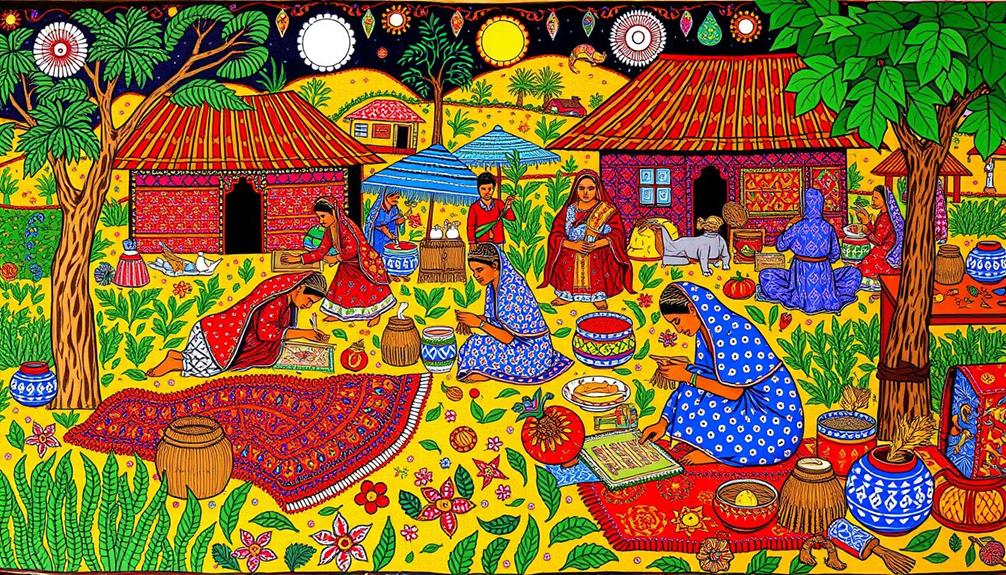
Often overlooked, the socio-economic impact of Madhubani painting on communities is profound. This vibrant art form not only showcases the talent of artists of Madhubani but also provides sustainable livelihoods for rural women, especially during economic hardships. By creating a path to financial independence and empowerment, Madhubani painting transforms lives.
Incorporating team-based games during community events can further enhance the bonding and collaboration among artists and their families.
The Shilp Sangh Cooperative Society plays an essential role, employing around 30-40 women artists and facilitating skill development. This collaboration across various age groups enhances their economic prospects, making art a viable source of income.
With government initiatives and cultural centers promoting Madhubani art, artists gain increased market access through workshops and exhibitions, further boosting their earnings.
Moreover, the commercialization of Madhubani art has invigorated local economies. As global interest grows, demand for these artworks in various formats rises, creating more opportunities for artisans.
Additionally, tourism growth driven by art exhibitions and cultural festivals in the Mithila region considerably reinforces this socio-economic impact, benefiting not just the artists but entire communities.
Global Recognition of Madhubani Art
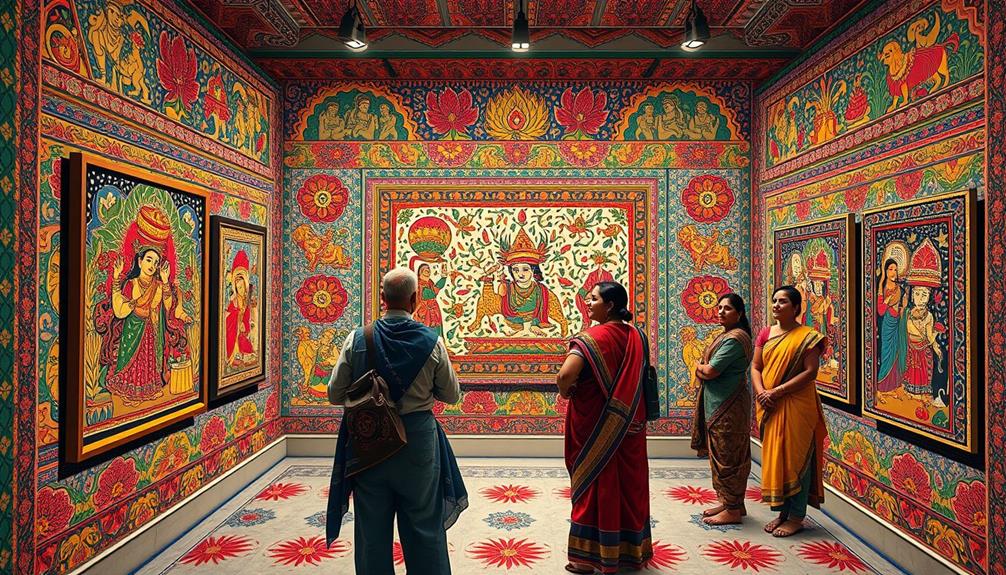
With its roots deeply embedded in the Mithila region of India, the Madhubani painting tradition has garnered global recognition since it first caught international attention in 1934. This vibrant art form has captivated audiences worldwide, finding its place in galleries and homes far beyond Indian borders.
Countries like Japan, Germany, and the USA have embraced this unique style, showcasing its appeal across cultures. The ongoing support from various organizations guarantees that the tradition is preserved and promoted, akin to the way community engagement is fostered in architectural circles.
Here are three key aspects of its global recognition:
- Mithila Museum in Japan: Housing around 900 Madhubani paintings, this museum highlights the international appreciation for the art of Madhubani.
- Publications and Documentaries: Numerous works dedicated to Madhubani art educate audiences globally, enhancing its profile in the art world.
- Collaborations with Fashion: Partnerships with international designers have led to innovative products, further expanding the reach and influence of Madhubani art in contemporary markets.
Organizations like the Master Craftsmen Association play an essential role in supporting artists, guaranteeing the art of Madhubani continues to thrive on the global stage.
Through these efforts, the tradition remains vibrant and relevant today.
Contemporary Adaptations and Innovations
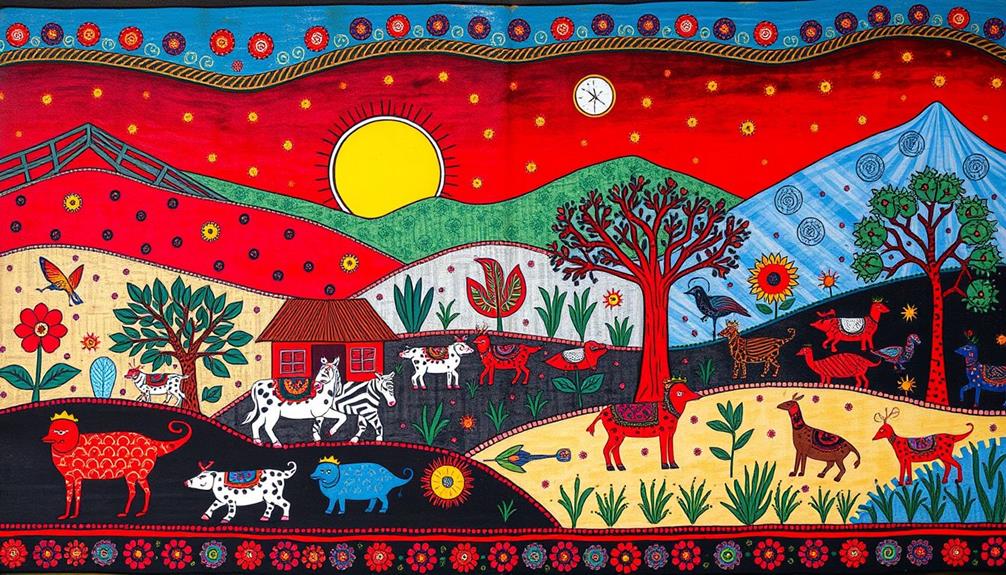
You'll notice how contemporary Madhubani artists are reinterpreting traditional techniques, creating fresh expressions that resonate with modern audiences.
Their innovative approaches often draw inspiration from contemporary art trends and explore themes that reflect current societal issues.
By fusing these vibrant designs with current fashion trends and exploring digital art, they're pushing the boundaries of this age-old craft.
This evolution not only preserves the art form but also makes it relevant in today's fast-paced world.
Modern Artistic Interpretations
Embracing the rich heritage of Madhubani painting, contemporary artists are redefining this ancient art form by infusing it with modern themes and techniques.
As seen in various artistic movements, such transformations often reflect a deeper connection to astrology and attractiveness, revealing how art can mirror personal and cultural identities.
You'll find that contemporary Madhubani artists aren't only preserving traditional methods but also exploring pressing issues like gender equality and environmental conservation through their vibrant works.
This evolution has led to a diverse range of modern artistic interpretations that resonate with today's audiences.
Here are three notable trends in modern Madhubani art:
- Home Decor: Artists are creating stunning wall hangings, cushions, and tableware that bring the essence of Madhubani into modern living spaces.
- Digital Art: The adaptation of Madhubani styles into digital formats allows for innovative expressions and broader reach, appealing to tech-savvy generations.
- Collaborative Projects: Partnerships with fashion designers have resulted in unique clothing lines that seamlessly blend Madhubani aesthetics with contemporary fashion principles.
These adaptations showcase how Madhubani art continues to evolve, making it relevant and engaging for a new audience while paying homage to its rich roots.
Fusion With Fashion Trends
Increasingly, contemporary fashion is embracing the vibrant motifs of Madhubani painting, creating a dynamic fusion that captivates audiences worldwide. This exciting fusion with fashion trends showcases how traditional motifs can seamlessly blend with modern aesthetics, producing unique clothing lines that appeal to a global market.
The collaboration between Madhubani artists and fashion designers has led to stunning garments featuring hand-painted designs, pushing the boundaries of sustainable fashion. You'll find these traditional patterns not just on clothing but also in home decor, like cushions and curtains, bringing cultural appreciation into everyday life.
Here's a quick overview of this fusion:
| Aspect | Description | Impact |
|---|---|---|
| Fashion | Hand-painted garments | Unique clothing lines |
| Home Decor | Cushions and curtains | Cultural presence |
| Global Reach | Exhibitions and online platforms | Wider audience engagement |
Through exhibitions and social media, Madhubani art is gaining recognition, proving its versatility and adaptability to contemporary trends. As you explore this unique intersection of art and fashion, you're witnessing a revival of cultural heritage in a modern context.
Digital Art Integration
The fusion of Madhubani painting with contemporary fashion has paved the way for exciting innovations in digital art integration. By blending traditional motifs with modern themes, artists are expanding the reach of this art form to a global audience.
This evolution mirrors trends seen in other creative fields, such as how AI-generated music is reshaping artistic expression. Digital platforms now allow artists to create, showcase, and sell their works while maintaining the rich heritage of Madhubani art.
Here are three ways digital art integration is transforming the Madhubani tradition:
- Workshops and Learning: Many workshops focus on digital techniques, encouraging young artists to experiment with software while preserving traditional elements, ensuring the craft evolves without losing its roots.
- Collaborations with Brands: Artists are partnering with fashion designers and brands, resulting in unique products that feature Madhubani designs in fashion, home decor, and merchandise, thereby increasing market visibility.
- Digital Storytelling: Short films and social media campaigns now highlight the cultural significance of Madhubani art, sharing the stories behind the artworks and engaging a wider audience.
These adaptations not only celebrate the tradition but also invite innovation, ensuring Madhubani painting remains relevant in today's artistic landscape.
Frequently Asked Questions
Why Is Madhubani Painting Famous in Bihar?
Madhubani painting's famous in Bihar because it showcases intricate designs and vibrant colors, reflecting local traditions and mythology. Its unique style, rooted in cultural heritage, empowers women artists and draws international attention, enhancing Bihar's artistic identity.
What Is the History of Madhubani Painting?
Did you know Madhubani painting dates back around 2500 years? You'll discover its roots in the Ramayana era, where it began as a decorative art form, primarily created by women for festivals and rituals.
What Is the Main Theme of Madhubani Painting?
The main theme of Madhubani painting revolves around Hindu mythology and spirituality. You'll notice vibrant depictions of deities, nature, and daily life, all rich with symbolism that reflects cultural values and contemporary societal issues.
What Is the Traditional Art of Bihar?
When it comes to traditional art of Bihar, you can't miss Madhubani painting. It's a vibrant expression of culture, featuring intricate designs that depict nature, deities, and rituals, often crafted by the talented local women.
Conclusion
In exploring the vibrant world of Madhubani painting, you uncover not just art but a living tapestry of culture, history, and resilience. This tradition, woven by skilled hands, tells stories that transcend borders and time, inviting you to see the beauty in every stroke. As Madhubani continues to evolve, it beckons you to appreciate its depth and significance—after all, isn't art the heartbeat of a community, connecting us all in shared expression?
